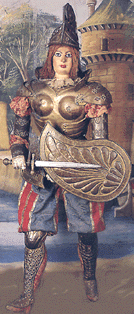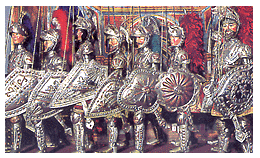...Best of Sicily
presents... Best of Sicily Magazine. ... Dedicated to Sicilian art, culture, history, people, places and all things Sicilian. |
by Antonella Gallo | ||
Magazine Best of Sicily Arts & Culture Fashion Food & Wine History & Culture About Us Travel Faqs Contact Map of Sicily |
The marionettes themselves are made of wood with cloth with metal accoutrements. A handful of marionette makers still work in Sicily, particularly in Palermo, Catania and Messina, and sell many of their creations as souvenirs. Quality varies, naturally, but the best Sicilian marionettes are among the world's finest. Stylistically, Palermitan, Catanian and Messinese marionettes are quite similar to those of Naples and Venice --no accident considering the maritime trade among these cities historically. Traditionally, certain families have specialized in marionette making and puppet theatre --the Cuticchios and Pasqualinos in Palermo, for example. It is a demanding field requiring numerous, highly-developed skills. Nobody is born a puppet master or puppeteer; it is an art learned over many years. The puppets are carved, painted and decorated. Sets are painted in the Sicilian folk style with traditional colours, using canvas for the backdrops. As with any visual or performing art, puppets and puppet theatre are very individual, reflecting each artist's personality and style. Apart from dramatic and historical figures, the Sicilian marionettes
are based on local folklore and comedy. There's Nofriu and Virticchiu in
Palermo, and Peppenninu in Catania. The Palermitan marionettes used in theatre
are about 80 centimetres in height, while Catanian ones are considerably
larger, at around 120 centimetres. Neapolitan marionettes are about a metre
tall. The various types of marionette used in Puppet theatre reached the height of its popularity in Sicily during the middle of the nineteenth century. An interest in puppet theatre faded with emergence of modern developments in the early decades of the twentieth century. Things like books of fairy tales (and increasing literacy that permitted parents to read the books to their children), film and animation. Conveniently for the new Italian state (the Kingdom of Italy) established in 1860, the traveling puppet shows, presented in the Sicilian language, began to disappear during a time when many of the themes they espoused, particularly the glory of the sovereign Kingdom of Sicily, were officially discouraged in favor of "national unity," the Italian language and then Fascism. Following a long decline, there has been a small resurgence of interest in puppet theatre in recent decades, coinciding with regionalist cultural movements supporting things like regional languages (dialects). The puppet theatres, and the Pasqualino Marionette Museum in Palermo, now receive some public funding to continue their work. Some of the greatest interest in Sicilian marionettes is found outside Sicily, and Sicilian puppeteers have enjoyed great success abroad. Charlemagne's legacy survives. The Cuticchio Puppet Theatre is located at Via Bara all'Olivella 95 in central Palermo. The Pasqualino Marionette Museum is on the second floor in a building at Via Butera 1 in the same city. About the Author: Artist Antonella Gallo teaches art in Rome. | |
Top of Page |
 They became popular in Sicily late in the Middle Ages, during the fifteenth century, and marionettes are still considered an important part of Sicilian folk
culture. Sicilian puppet theatre (opera dei pupi) or, more properly, "marionette
theatre," developed into its present form in the eighteenth century.
(Strictly speaking, "puppets" fit over the hand, while marionettes
are figures controlled by strings, but in common parlance the terms are
often used interchangeably; what we're describing are actually marionettes.)
Typically, the marionettes and their theatre depict medieval characters
and legendary events based loosely on history. There's Orlando (Roland),
one of Charlemagne's knights, and the Norman knights of King Roger of Sicily.
And Saracens (Moors). Baroque paladins, really, since their costumes are
often more reminiscient of sixteenth century decoration than medieval armor
and clothes. More recently, the puppeteers adapted stories of the Sicilian
aristocracy (such as "The Baroness of Carini") to their tiny stages.
As folk art, the productions are typically expressions of the popular perception
of personages and events rather than faithful chronicles of history and
literature. That was always the idea of this kind of entertainment. It wasn't
meant to be informative so much as inspirational. Inspirational? Inspirational
in the sense that spectators might in some way compare the stories or characters
to their own lives. Puppet theatre sometimes provided an innocent alternative
to the passion plays of the Church. It could even be mildly revolutionary,
though most themes served to idealize the nobility which controlled Sicily,
reinforcing the strictures of a feudal society that existed in the countryside.
While it eventually became a popular entertainment for children, it appealed
to adults, too.
They became popular in Sicily late in the Middle Ages, during the fifteenth century, and marionettes are still considered an important part of Sicilian folk
culture. Sicilian puppet theatre (opera dei pupi) or, more properly, "marionette
theatre," developed into its present form in the eighteenth century.
(Strictly speaking, "puppets" fit over the hand, while marionettes
are figures controlled by strings, but in common parlance the terms are
often used interchangeably; what we're describing are actually marionettes.)
Typically, the marionettes and their theatre depict medieval characters
and legendary events based loosely on history. There's Orlando (Roland),
one of Charlemagne's knights, and the Norman knights of King Roger of Sicily.
And Saracens (Moors). Baroque paladins, really, since their costumes are
often more reminiscient of sixteenth century decoration than medieval armor
and clothes. More recently, the puppeteers adapted stories of the Sicilian
aristocracy (such as "The Baroness of Carini") to their tiny stages.
As folk art, the productions are typically expressions of the popular perception
of personages and events rather than faithful chronicles of history and
literature. That was always the idea of this kind of entertainment. It wasn't
meant to be informative so much as inspirational. Inspirational? Inspirational
in the sense that spectators might in some way compare the stories or characters
to their own lives. Puppet theatre sometimes provided an innocent alternative
to the passion plays of the Church. It could even be mildly revolutionary,
though most themes served to idealize the nobility which controlled Sicily,
reinforcing the strictures of a feudal society that existed in the countryside.
While it eventually became a popular entertainment for children, it appealed
to adults, too. southern Italy differ not
only in size, which dictates the dimension of the stages used, but also
in the placement of the suspending strings and hinge joints which permit
movement. Outside Italy, the marionettes and puppet theatre most similar
to Italian ones are those of Belgium.
southern Italy differ not
only in size, which dictates the dimension of the stages used, but also
in the placement of the suspending strings and hinge joints which permit
movement. Outside Italy, the marionettes and puppet theatre most similar
to Italian ones are those of Belgium.